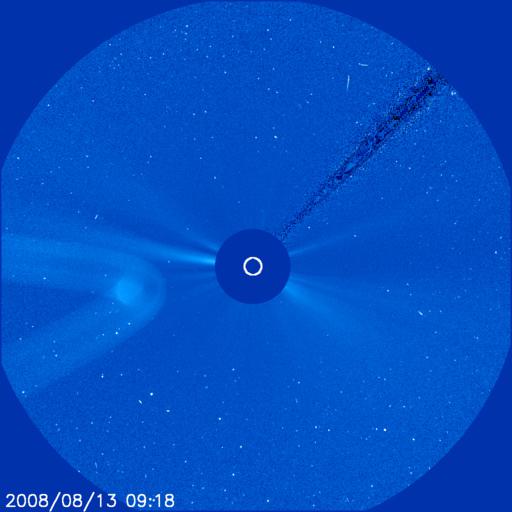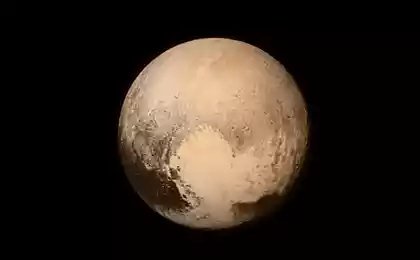598
Planet X is found
Hidden from Earth telescopes of its remoteness, Planet X, it seems, is still detected. When checking the photos made a telescope satellite SOHO LASCO C-3, it was found that the planet appears regularly, every August, gradually approaching the Earth.
Here you can check the photos themselves by LASCO C3, and configuring search on the month of August different years. Or here
This photograph was taken 13.08.2008 year

The following quote an article from National Geographic in 2012, which suggests the existence of this planet.
news.nationalgeographic.com/news/20...-space-science/
Astronomers believe that Planet X exists
Posted on June 2, 2012 |
The debate about the reality of "Planet X" - the mysterious hypothetical planet, located on the edge of the solar system, continued with renewed vigor due to computation of a famous astronomer.
According to Rodney Gomez, an astronomer at the National Observatory in Rio de Janeiro, irregular orbit of small icy bodies beyond the orbit of Neptune, show that at the boundary of the solar system revolves planet that is four times larger than the Earth in size.
The debate about the existence of Planet X has been going on for decades, but so far no one has been able to prove anything.
Gomez spent the measurements for 92 orbits of Kuiper Belt objects - dwarf planets and small bodies - and argues that the six objects orbit somewhat deviated from the expected.
On Tuesday, Gomez told the astronomers of the Astronomical Society of the United States, which is likely to cause irregular orbit lies in the "planetary mass object" massive enough to affect objects in the Kuiper belt.
Gomez data show that the planet must be greater than the Earth's size is at least four times. And it is about 1,500 times farther away from our star than the Earth.
It can also be an object, comparable to Mars and rotating at a distance of about 5 billion kilometers from Earth - not far from the orbit of Neptune.
But when you consider the distance that are on earth, astronomers can barely even catch a glimpse of a possible new planet in our solar system.
According to Rory Barnes of the University of Washington, Gomez suggested a way to determine how such a planet can participate in shaping parts of our solar system.
Pluto, the ninth planet the previous, is one of the largest dwarf planets such as the Kuiper Belt. Its size reaches approximately 2,500 kilometers wide.
His planetary status was removed in 2006 because it does not meet all the criteria of the planets - in particular, its mass is not enough for you to remove the surrounding objects from its orbit.
This photograph was taken 16.08.2009 year

Source:
Here you can check the photos themselves by LASCO C3, and configuring search on the month of August different years. Or here
This photograph was taken 13.08.2008 year

The following quote an article from National Geographic in 2012, which suggests the existence of this planet.
news.nationalgeographic.com/news/20...-space-science/
Astronomers believe that Planet X exists
Posted on June 2, 2012 |
The debate about the reality of "Planet X" - the mysterious hypothetical planet, located on the edge of the solar system, continued with renewed vigor due to computation of a famous astronomer.
According to Rodney Gomez, an astronomer at the National Observatory in Rio de Janeiro, irregular orbit of small icy bodies beyond the orbit of Neptune, show that at the boundary of the solar system revolves planet that is four times larger than the Earth in size.
The debate about the existence of Planet X has been going on for decades, but so far no one has been able to prove anything.
Gomez spent the measurements for 92 orbits of Kuiper Belt objects - dwarf planets and small bodies - and argues that the six objects orbit somewhat deviated from the expected.
On Tuesday, Gomez told the astronomers of the Astronomical Society of the United States, which is likely to cause irregular orbit lies in the "planetary mass object" massive enough to affect objects in the Kuiper belt.
Gomez data show that the planet must be greater than the Earth's size is at least four times. And it is about 1,500 times farther away from our star than the Earth.
It can also be an object, comparable to Mars and rotating at a distance of about 5 billion kilometers from Earth - not far from the orbit of Neptune.
But when you consider the distance that are on earth, astronomers can barely even catch a glimpse of a possible new planet in our solar system.
According to Rory Barnes of the University of Washington, Gomez suggested a way to determine how such a planet can participate in shaping parts of our solar system.
Pluto, the ninth planet the previous, is one of the largest dwarf planets such as the Kuiper Belt. Its size reaches approximately 2,500 kilometers wide.
His planetary status was removed in 2006 because it does not meet all the criteria of the planets - in particular, its mass is not enough for you to remove the surrounding objects from its orbit.
This photograph was taken 16.08.2009 year

Source:























